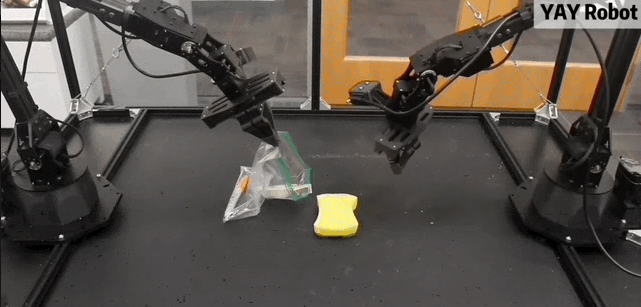No, this is not a new optimistic robot that requires positive reinforcement. Stanford researchers have introduced YAY, a system that lets you yell instructions at your robot to improve its performance in real-time. This approach goes beyond standard programming, allowing for dynamic adjustments during tasks.
The robot gets better in real-time as it learns from the user’s instructions
Imagine your robot struggling to put a soft ball in a box. With YAY, you can simply shout “Squeeze the ball” and the robot will adapt its strategy. These corrective instructions are then stored by the system to enhance future performance. YAY allows the user to give shouted orders for complex tasks like bagging groceries, mixing fruits, and washing dishes. These tasks often require bimanual manipulation and handling soft objects like sponges, where precise control is crucial.

For example, if the robot drops a sponge while bagging groceries, you can shout “Move to me, then left” to guide it. The robot might need a few tries, but it will learn from the “go left” command to eventually succeed.
Beyond error correction, YAY allows you to adjust task details on the fly. Let’s say the robot grabs too much candy while filling a box. Shouting “Less!” prompts the robot to put some candy back. These human-issued instructions are used to fine-tune the system, leading to a reported 20% increase in successful task completion.
YAY’s architecture revolves around high-level and low-level strategies. The high-level strategy analyzes camera data and generates instructions for the low-level strategy, which controls the robot’s movements. Importantly, human voice commands override everything else, ensuring real-time correction.
The system also incorporates a feedback loop. Verbal corrections are recorded and used to refine the high-level strategy, making the robot less reliant on immediate voice commands over time. This allows for continuous learning and improvement even after basic training. YAY holds promise for creating adaptable housework robots that can respond to our needs and learn from our guidance. Let’s see how this evolves in the near future.
RELATED:
- Robot designed in Australia and manufactured in China poses a challenge to Zoom and Google Meet
- Lenovo Unveils the “Daystar Bot GS” Robot Dog Companion
- Big Discount: AOOSTAR R1 N100 NAS Mini PC Only For $159
- Get $100 Off on Vivo X100 Pro at Giztop
- Best of MWC 2024: AI Phone, Transparent Laptop, 3D Tablet & More
(Via)







